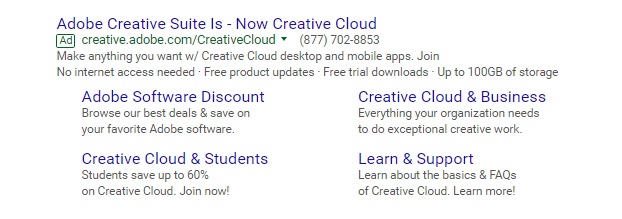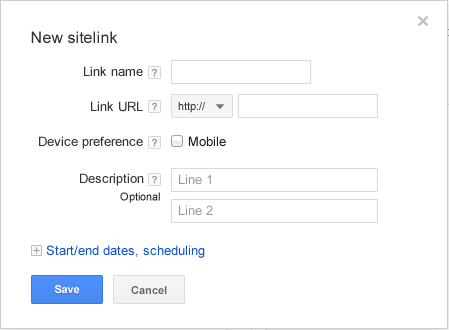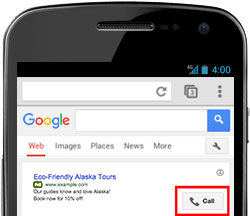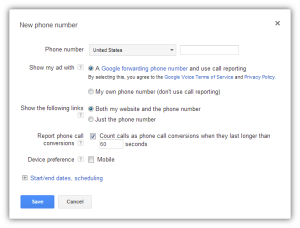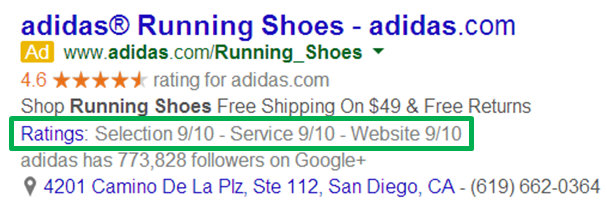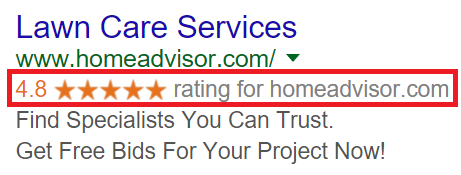A Guide to Google AdWords Extensions
Managing an AdWords campaign is no day at the beach. It requires countless hours of keyword research, spreadsheets full of information on match types and search volume, and rows and rows of ad copy. Oftentimes it’s a guessing game, as marketers try to uncover the perfect sweet spot where affordable bid prices meet their desired conversion rates. But even those who put forth the hard yards might still be selling their brand short. One of the better features on Google AdWords is one that many SEMs don’t fully explore. We’re talking about ad extensions, the platform’s most useful, untapped resource.
What Are Google AdWords Ad Extensions?
Ever feel like your AdWords ads are too small? Like you aren’t able to convey enough actionable brand information to potential leads? Ad extensions help to solve this problem by adding a bigger region for you to expand your message.
Let’s take a look at a standard AdWords ad:
And one with an ad extension:
As you can see, the latter gives consumers links to more landing pages, allowing them to select the right content to satisfy their individual need. More options means more ways for searchers to interact with your ad, which translates to a higher conversion rate. You want your audience to have as much knowledge about your brand as possible, right? This is an easy way of providing that extra bit of information for them.
There’s also an aesthetic advantage to using ad extensions. They literally take up more space on search results pages, drawing greater attention to your brand while consuming space away from smaller ads. Plus, there’s NO EXTRA CHARGE. AdWords never charges you for taking up extra real estate, they only charge you a cost per click (CPC). It doesn’t matter if a searcher clicks on your extension or ad headline, the CPC stays the same.
Let’s get started by breaking down each of Google AdWords’ ad extensions and explain why they may or may not be right for you.
Sitelinks Extensions
The first option under your ad extensions list is for sitelinks extensions. This simply allows you to post hyperlinks to your site as well as offer brief—and I mean VERY brief—descriptions about each page. There are a couple different forms of sitelinks, one being just hyperlinks and the other including descriptions. For example, here’s what it looks like with just the links:
And here is a longer sitelink:
Clearly the longer form sitelinks are the way to go, right? Not necessarily. The problem with AdWords is that it might not allow your site link descriptions to show up in search results. To play it safe it’s advised that you format your sitelinks in a way that doesn’t sell yourself short regardless of how Google wants to display your ad. Focus on page headlines first and foremost before worrying about any page descriptions.
Adding sitelink extensions couldn’t be easier. Just go into AdWords and click on your Ad extensions tab. From there, click the box that reads “View: Sitelink extensions” then click on the “+Extensions” option. You’ll see a pop-up window like this:
It’s pretty self-explanatory. You just have to provide the “Link name,” which is the all-important title of the hyperlink, followed by the landing page URL. Then you can check a box to determine whether your extension will display on mobile devices or not, and then type in a one to two line description detailing the link. You can also edit the start/end dates of your links and schedule them out.
Sitelinks are a great way to show potential customers the breadth of your website’s offerings, increasing the possibility of their eventual engagement with your brand. For physical, location-specific stores, you might have greater success with the next extension options.
Location Extensions
Do you operate a service business? I.e. a restaurant, retail store, auto shop, or my personal favorite, a brewery? Then you’ll definitely want to implement location extensions. Whereas sitelinks extensions are intended to guide searchers to your website, location extensions are designed to get them to your place of business.
For local businesses in competitive keyword niches, like “plumbing” or “local insurance offices,” having your address plastered beneath your ad is an absolute must. Oftentimes someone who’s searching for your local service needs to get to you right away, especially when they need an auto shop or insurance office. People can click on your location’s link and it will connect them to Google Maps, showing them how to get to your store immediately.
Within your Ad extensions tab, click on “View: Location extensions” and type in your information, including store hours so people know when you’re open.
Many service businesses that are new to PPC seem to forget about these extensions. If you’re consulting one of these businesses, don’t let such a valuable opportunity go by the wayside!
Call Extensions
Another must-have extension for service businesses are call extensions. In addition to having your physical address listed in a location extension, you want to have a number listed where people can reach you. Call extensions allow you this chance. Just be mindful of one thing, a call is the same value as a click. Whenever consumers click on your call extension, it’s the same cost as if they clicked on your headline.
Since clicking on a call extension means consumers are trying to speak with you, these types of extensions are shown with the following “call” icon when a person is on their mobile device.
Call extensions won’t work if you’re running a campaign for “Display Network only – Remarketing” or campaigns with a marketing objective of “Install your mobile app,” or “Engage with your mobile app.”
Otherwise, you’re good to go. Just make sure that your ad copy is neat and concise considering most consumers will be looking at this particular extension from their phones.
When entering you call extensions information, AdWords allows you to specify how many seconds a phone call will last before it’s counted as a “conversion.” This helps with your AdWords and Google Analytics reporting.
App Extensions
With app extensions, you can provide links to your mobile or tablet app from your AdWords ads. People can still click on your ad headline to go to your website, but they can also click on a link to go straight to your app.
This has some unique advantages for both conversion rate and your reporting. By giving users more options of platforms they can engage with you on, you’re giving yourself a better chance of them converting. Your reports will show which part of the ad received the most clicks, helping you decide whether your app extension is actually the thing that’s improving ROI or not.
App extensions also features “smart” detection, which determines a customer’s device type. This way if you have an app that only works on iPhones, you can target users on just those devices. Conversely, if your app only works on tablets you can target those users. All you have to do is create an app link for each app store where you’re selling—like the Apple Store or Google Play, among others.
Review Extensions
Testimonials are among the most effective ways of getting the word out about your product. 88% of consumers say that they trust online reviews as much as personal recommendations, meaning that insightful, positive reviews are a huge key to driving leads. AdWords knows this and offers you the ability to place reviews as extensions to your ads.
Next to each review you can type in the source website. This is very important because if the review comes from a major site, it will lend your brand a lot more credibility. Plus, Google only approves review extensions that come from reputable sites, which is something you must keep in mind so as not to waste time getting your review extensions continually rejected.
What are some examples of reputable third-party review sites, in the eyes of Google? Try places like Entrepreneur, TrustPilot, Forbes, ConsumerAffairs, Angie’s List, or Better Business Bureau. A positive review on any of these sites will have no problem passing Google’s approval process.
Review extensions don’t appear on mobile or tablet devices. They can only be seen on desktop devices as well as on the Google Search Network, and are available in at least 8 different languages. Try to keep their text style different from your regular ad text so that they stand out better for consumers. Italicized text is often the way to go.
It’s wise to scroll through Google’s Support page to make sure you’re following all the rules for review extensions. For example, you can’t use reviews that were written more than a year ago and you can’t change the way it was originally written.
Callout Extensions
Want to entice potential consumers with special offers like free shipping or expedited delivery? Callout extensions are 2-3 word statements expressing a quick incentive for consumers to buy from you.
Think of callouts as a way to provide quick yet vital selling points, describing some aspect of your service that makes you unique. Oftentimes, these are the pieces of text that are ultimately responsible for driving people to your site.
Structured Snippet Extensions
A good way to convey specific product or service offerings in your ad is through structure snippet extensions. These appear underneath your main ad text, and are formatted with a subject followed by a list. For example, an electrician could use the space to enumerate his service offerings, formatted like this…
“Services: repair, maintenance, installations, fixtures.”
Here’s a look at an AdWords ad with a structured snippet extension for a travel website:
Structured snippets don’t have very high impression shares compared to that of other extensions, but they might be effective for expressing information about multiple product offerings or service options.
Automated Extensions Report
The last option on your list reads Automated Extensions Report. This shows you how well your ads are performing when automated extensions are shown in them. These are options implemented into your ad as predicted by AdWords, with the goal of improving your ad’s performance. Once a given extension is predicted, AdWords automatically creates and displays it beneath your ad.
Here are the Automated extensions options:
- Automated Call Extension
AdWords might conclude that your business relies on people calling it, thus triggering an automated call extension.
- Dynamic Sitelink Extensions
Rather than creating new sitelink extensions on your own, dynamic ones are made automatically. They connect people to the right pages on your site based on the most conversion-focused sections that promote user action. They are only shown when AdWords deems it could boost your ad’s performance; however, if you already have a regular sitelinks extension running then the dynamic extension won’t appear.
- Dynamic Structured Snippet Extensions
If someone searches for a particular service that matches content on your landing page, AdWords might trigger a dynamic structured snippet extension to appear. For this version, they are only available for ads targeting English speakers.
- Consumer Rating Extensions
These consumer ratings are taken from surveys throughout your industry. AdWords can show anywhere between 1-3 of these ratings in a given ad. AdWords runs surveys on a regular basis to gauge consumer sentiment within specific industries. They then add up the totals and come up with a benchmark score used to compare your brand with others. This is the rating you see in the extension.
- Seller Rating Extensions
These are numerical ratings next to a star rating, taken from aggregated business reviews found by Google. AdWords compiles your scores into an average and that’s what appears here.
Scores will only appear if a business has 150 or more unique reviews and a composite rating of 3.5 stars or above.
- Previous Visits
A sneaky little extension, Previous Visits reminds your potential consumers of a) how many times they’ve visited your site, and b) when was the last time they visited.
You never know, it just might plant a seed in your consumers’ heads that NOW is the time to buy!
Experimentation is Key
While sitelinks extensions typically have the highest conversion rate of any extensions, it doesn’t mean that all others should be ignored. Depending on the size of your business, your service offerings, and goals, certain extensions might benefit your ROI better than others. Like with anything PPC related, experimentation is key.






